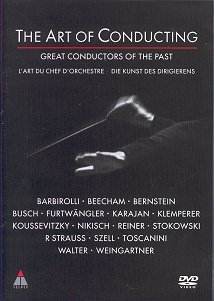This production is superb, and should be in the collection
of anyone in the least bit interested in the history of the conductor
in relation to western classical music. The time span covered by the
virtuoso orchestral conductor is from the 1930s until the late 20th
century. This DVD avoids living maestri, and I suppose that the so called
‘golden era’ was before most of today’s living conductors started plying
their trade. The video has won all sorts of awards when it was released
as a videotape, and I wouldn’t be surprised to see this DVD and its
companion win the same accolades. Is the DVD worth buying if you already
possess the video? Most certainly ‘yes’, because of the vastly superior
search facilities of the DVD compared with the video. Many of the excerpts
are also lengthened, and also there are interviews with various contemporary
commentators to enhance the experience. The interviews are illuminating
in all cases, except that I find those by Hugh Bean, whilst useful,
a bit of a trial due to his somewhat stunted interviewing style. Still
the content is superb.
The DVD shows the conductors mentioned above in action
both in rehearsal and performance. If I were to single out one excerpt
to give you a flavour of why a recording like this is so important,
I would choose the famous clip of Furtwängler rehearsing the Berlin
Philharmonic in London just after the second world war in the finale
of Brahms’ Fourth Symphony. Watching this, you can appreciate the life
and power that Furtwängler was able to convey to his players. The
concentration on their faces says more that any comments I could make
to persuade you to buy this disc. Watching these excerpts you may also
understand why the older recordings of staple works left to us by these
masters continue to be bought by music lovers instead of the chromium
plated but generally dull performances issued by many of their successors.
There are a small number of complete works on this
disc, Weber’s overture to Der Freischütz, conducted by Felix
Weingartner with the Paris Symphony Orchestra, recorded in Paris in
1932, and Wagner’s Tannhäuser prelude with Fritz Busch in Dresden
in 1932. The fact that nearly all of the remainder of the excerpts are
just that is no distraction or indeed shortcoming. The total drive of
the programme is to investigate what it was that made these musicians
the artists they were, and in this respect, the recording satisfies
with flying colours.
Another advantage of the DVD over the videotape is
the quality and stability of the images. This DVD really excels in this
respect. You would not think so, given the age of the recordings and
the primitive nature of some of the sound recordings. The technicians
have worked wonders with the original material, and now we have these
items in a near indestructible form
To maintain the archival nature of the material, the
items featuring Herbert von Karajan use his earlier recording of the
Beethoven 5th Symphony but colour is used in the Debussy
La Mer excerpt. The same applies to the Leonard Bernstein recordings
where colour is used only on the second excerpt (Mahler’s 4th
Symphony). There is even a film clip of a silent conductor – Nikisch
conducting, God know’s what, in absolute silence. Even so this is still
fascinating, since it illustrates elements of conducting technique which
are true even today. If you hold your baton high, it forces the players
to see the conductor’s face. It is the eyes which do most of the control,
unless, of course, your name is von Karajan, when other methods apply.
A wonderful DVD, one which I will return to many, many
times, and there could be no higher compliment made to a recording than
this.
John Phillips

![]() Barbirolli, Beecham,
Bernstein, Busch, Furtwängler, Karajan, Klemperer, Koussevitsky,
Nikisch, Reiner, Stokowski, R. Strauss, Szell, Toscanini, Walter and Weingartner.
Barbirolli, Beecham,
Bernstein, Busch, Furtwängler, Karajan, Klemperer, Koussevitsky,
Nikisch, Reiner, Stokowski, R. Strauss, Szell, Toscanini, Walter and Weingartner.![]()
![]() WARNER MUSIC VISION 0927 42667-2 DVD [164 mins]
WARNER MUSIC VISION 0927 42667-2 DVD [164 mins]